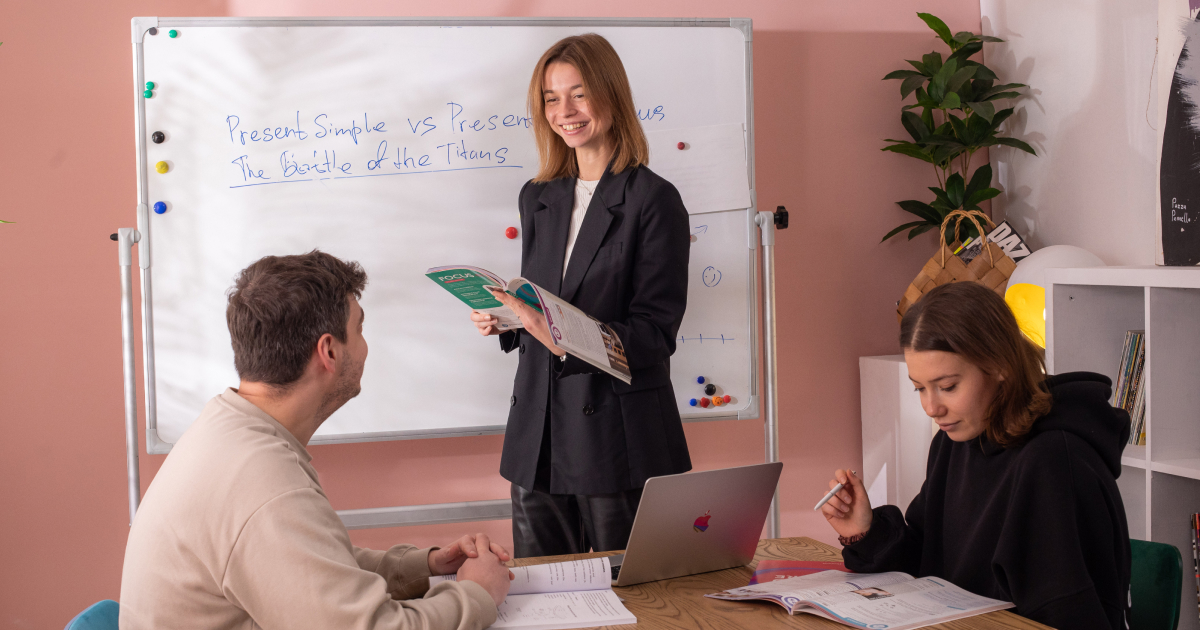From Netflix to news articles: using authentic materials in language teaching
- Activities
- Tips & Strategies
- Methodology

14.01.2025
In every classroom, there is usually at least one student who falls behind their peers.
This can occur for various reasons, and such situations often prompt us as teachers to offer our assistance.
But how can we help a student catch up without overwhelming him with extra assignments or applying unnecessary pressure?
Each case is unique, and the methods for addressing the issue can differ.
In this article, we will explore specific steps that can be taken to support the student and help them regain their confidence in keeping pace with the rest of the class.
To help a student catch up with their peers, it's crucial to understand the underlying reasons for their difficulties.
Each student has their own unique circumstances and background that can affect their academic performance.
The cause may lie in personal issues, frequent absences due to illness, or struggles with understanding certain topics.
It’s also possible that they’re facing social challenges, such as bullying, which can negatively impact their studies.
Another important factor to consider is the student’s learning style and pace.
Students absorb information differently: some grasp new concepts quickly, while others require more time to fully understand the material.
If lessons are progressing too rapidly, the student may struggle to keep up.
In such cases, carefully observe the student's behaviour and responses in class.
Take note of their participation level, engagement, and interest.
These observations, combined with an open conversation with the student, can provide a clearer picture of their situation and help identify the specific reasons behind their struggles.

Teach teenagers with confidence!
Join our courseAfter identifying the cause of the student's underperformance, it’s important to select suitable strategies to help them make progress.
Let's explore a few of them.
Regular testing allows teachers to consistently track the student’s grasp of the material and catch any gaps early on.
These mini-tests or tasks should be perceived as brief check-ins rather than full exams, focusing on a few recently covered topics.
Various formats can be used, such as flashcards, mini-quizzes, or online tests.
Differentiation can take various forms, as students learn in different ways.
Some may benefit more from visual aids, while others find detailed explanations more helpful.
Tasks can be tailored to match a student’s learning style.
For example, if grammar is a challenge, using additional visual aids can be beneficial.
If a student finds longer written tasks difficult, breaking them down into smaller steps with specific goals can help make the process more manageable and track progress more effectively.

5 tips for teaching English to teenagers
Read nowWhile differentiated tasks can include elements that tap into a student's interests, this doesn't mean the entire curriculum should be altered for one individual.
Instead, it’s about accommodating their needs and preferences within the existing lessons, without adding undue pressure on the entire class.
For instance, if a student is interested in sports, occasional adaptations to reading materials could feature articles about sports events or athletes.
This way, while one student reads about a topic that engages them, the others can work with similar texts on the main theme.
This approach ensures group cohesion while allowing each student to progress at their own pace.
The goal is to incorporate diverse elements into tasks that are suitable for the whole class, yet offer additional options for those requiring extra support.
Such a strategy fosters an inclusive learning environment, where every student feels part of the group while still having the chance to work with materials that reflect their interests and meet their specific needs.

At times, teachers may need to reassess their current teaching methods.
This doesn't necessarily require a complete overhaul of the curriculum.
Instead, it demands flexibility and willingness to adapt strategies according to the situation.
It's essential to recognise that every student is unique: methods that may work well for one student could prove ineffective for another.
Consider diversifying assignments to accommodate different levels of readiness.
At Grade University, we offer a course called The Motivated Teen: Strategies for Language Teaching, which aims to help you understand teenagers' needs and foster a positive learning environment.
You will explore how physical, emotional, and social changes influence their motivation and behaviour, while also gaining practical tools to enhance student engagement.
Our TEFL/TESOL courses can be completed at your convenience, whether at home or elsewhere.
Each course includes a free demo version, enabling you to evaluate the quality of the materials before making a purchase.
5 ESL teaching methods for you to know as an English teacher
Creating a positive atmosphere in the classroom can be effectively achieved by recognising and encouraging students for their achievements, no matter how small.
Praise serves as a powerful tool that fosters self-confidence among learners.
For instance, if a student answers a question incorrectly but demonstrates genuine effort, it’s essential to acknowledge their attempt.
By celebrating these achievements, you inspire students to continue striving and help them overcome the fear of making mistakes.
Involving parents in the educational process is a crucial step that can significantly influence students' success.
Regular meetings or parents' evenings should be organised to discuss the achievements and challenges faced by students.
Additionally, it’s beneficial to provide specific recommendations in advance to the parents of struggling students on how they can support their child’s learning.

Gamification strategies for engaging language learners
Read nowFor example, suggest resources for extra practice during the student's free time.
You might also recommend online resources that incorporate gamification elements, making the learning experience more engaging and less monotonous.
By collaborating with parents in this way, you can collectively support the student and foster a positive atmosphere for their development.
The success of a student largely depends on understanding their individual needs and the support they receive both inside and outside the classroom.
To help students catch up with their peers, it is essential to apply a variety of strategies that take their unique characteristics into account.
By creating a comfortable environment for struggling students, we assist them in overcoming their current difficulties.
In doing so, you foster an inclusive atmosphere where each student can learn the subject at their own pace.
Assigning additional homework is the most effective way to help a student catch up.
Kateryna Kuchynska
Author
Content Manager | Teacher of General English
Comments
Leave your comment